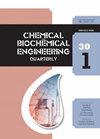Converting Waste into Products and Energy Using Complete Circular Economy and the Hydrogen Effect Technique to Reduce Dependence on Natural Gas
IF 0.9
4区 生物学
Q4 BIOTECHNOLOGY & APPLIED MICROBIOLOGY
引用次数: 0
Abstract
Conversion of waste into products and energy has the potential to reduce CO 2 emis - sion through implementation of a complete circular economy and utilisation of the hy - drogen effect technique. This study considers the novelties of the hydrogen effect tech - nique, which incorporates an upgraded input unit mathematical model. It includes real-simulated results obtained using an Aspen Plus ® simulator, and enlarged production. This technique is developed for optimal municipal solid waste (MSW) combustion, gas - ification, and reforming, presented as an upgraded input unit for syngas production, which can reduce CO 2 emissions by 3·10 6 kmol a –1 . This approach is exemplified by utilizing existing methanol and dimethyl ether production processes from natural gas, as they can be achieved and exceeded using MSW with varying hydrogen amounts. The optimal upgraded methanol and dimethyl ether production processes can increase pro - duction by 47 % and 16 %, including only the upgraded input unit, as well as decrease the temperature in the product reactors by 30 °C.利用完全循环经济和氢效应技术将废物转化为产品和能源,减少对天然气的依赖
通过实施完整的循环经济和利用氢效应技术,将废物转化为产品和能源有可能减少二氧化碳的排放。本研究考虑了氢效应技术的新颖性,它包含了一个升级的输入单元数学模型。它包括使用Aspen Plus®模拟器获得的真实模拟结果,以及扩大的生产。该技术是针对城市生活垃圾(MSW)的最佳燃烧、气化和转化而开发的,作为合成气生产的升级投入单元,可以减少3·10.6 kmol a - 1的CO 2排放。该方法通过利用现有的天然气甲醇和二甲醚生产工艺来实现,因为它们可以通过使用含不同氢量的城市生活垃圾来实现和超越。优化后的甲醇和二甲醚生产工艺,仅包括升级后的输入装置,可使产量分别提高47%和16%,并使产物反应器温度降低30℃。
本文章由计算机程序翻译,如有差异,请以英文原文为准。
求助全文
约1分钟内获得全文
求助全文
来源期刊
CiteScore
2.70
自引率
6.70%
发文量
23
审稿时长
>12 weeks
期刊介绍:
The journal provides an international forum for presentation of original papers, reviews and discussions on the latest developments in chemical and biochemical engineering. The scope of the journal is wide and no limitation except relevance to chemical and biochemical engineering is required.
The criteria for the acceptance of papers are originality, quality of work and clarity of style. All papers are subject to reviewing by at least two international experts (blind peer review).
The language of the journal is English. Final versions of the manuscripts are subject to metric (SI units and IUPAC recommendations) and English language reviewing.
Editor and Editorial board make the final decision about acceptance of a manuscript.
Page charges are excluded.

 求助内容:
求助内容: 应助结果提醒方式:
应助结果提醒方式:


